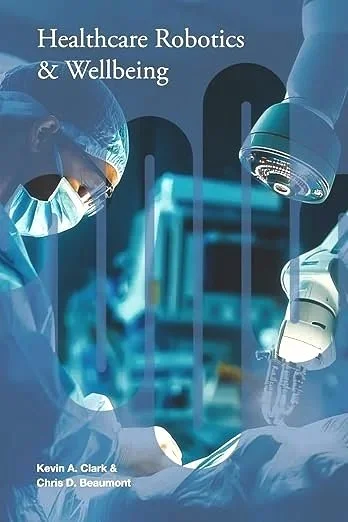Healthcare Robotics & Wellbeing
Cognitive World Member Article
The Evolution of Healthcare Technology and the Role of Robotics and Automation
Human health has witnessed a remarkable transformation. With more to come.
Over the years technological advancement that has revolutionized the way we deliver and receive care.
From the advent of antibiotics to the development of next generation imaging techniques, tech advancement has played a crucial role in improving patient outcomes and enhancing the overall quality of healthcare services. In recent years, the integration of automation, AI and robotics has further accelerated this evolution, opening new possibilities for precision, efficiency, and radical departures for rethinking how we create high quality healthspans.
The Rise of Robotics in Healthcare
Robotics, the science of designing and deploying embodied intelligence, has made significant inroads into the healthcare sector. These machines and systems, equipped with sensors, actuators, and artificial intelligence, can perform a wide range of tasks, from surgical procedures to patient rehabilitation.
Surgical Robotics: One of the most prominent applications of robotics in healthcare is in the field of surgery. Surgical robots, such as the da Vinci Surgical System, offer several advantages over traditional laparoscopic surgery, including greater precision, dexterity, and visualization. These systems allow surgeons to perform complex procedures with minimal invasiveness, resulting in faster recovery times and reduced patient discomfort.
Surgical Simulation and Training: Robotic simulators can provide surgeons with opportunities to practice complex procedures in a virtual environment, improving their skills and reducing the risk of errors.
Rehabilitation Robotics: Robotics is also being used to assist patient rehabilitation. Robotic devices can provide targeted therapy to individuals recovering from injuries or strokes. These devices can guide patients through exercises, providing real-time feedback and adjusting the intensity of the therapy as needed.
Pharmacy Automation: Automation in pharmacies significantly improves the accuracy and efficiency of dispensing medications. Automated dispensing systems can accurately fill prescriptions, reducing the risk of medication errors and ensuring that patients receive the correct medications.
Telemedicine and Remote Monitoring: Robotics can enable remote patient monitoring and augment telemedicine consultations. Telepresence robots, for example, can allow healthcare providers to remotely interact with patients, particularly in rural or underserved areas.
Wearable Devices and Data Analytics: Wearable devices can collect valuable health data, which can be analyzed by AI-powered algorithms to identify potential health risks and provide personalized recommendations. (Note: Not all robots are wearable, and not all wearables are robotic)
The Benefits of Automation in Healthcare
Automation, the use of technology to perform tasks with minimal human intervention, has the potential to streamline healthcare processes and reduce errors. Some of the key benefits of automation include improved efficiency, accuracy, accessibility, and cost reduction. Let’s explore each of these briefly:
Improved Efficiency: Automated systems can perform routine tasks more quickly and accurately than humans, freeing up healthcare professionals to focus on more complex and critical tasks.
Enhanced Accuracy: Automation can reduce the risk of human error, which is particularly important in tasks such as medication administration and laboratory testing.
Increased Accessibility: Automation can help to expand access to healthcare services, especially in remote and underserved areas.
Cost Reduction: By automating repetitive tasks, healthcare organizations can reduce labor costs and improve overall efficiency.
Challenges and Considerations
While the integration of robotics and automation in healthcare offers numerous benefits, there are also challenges and considerations to be addressed that include the initial investment, maintenance, training, ethics, data privacy and security.
Initial Investment: The initial cost of acquiring and implementing robotic systems can be significant.
Maintenance and Training: Ongoing maintenance and training are necessary to ensure the proper functioning of these systems.
Ethical Considerations and Regulatory Frameworks: As robotics and automation become more prevalent in healthcare, it is essential to establish ethical guidelines and regulatory frameworks to ensure their safe and responsible use. The use of robotics and automation in healthcare raises ethical questions about the role of technology in patient care and the potential for job displacement.
Data Privacy and Security: As healthcare systems become increasingly reliant on technology, there is a heightened need to protect patient data and ensure cybersecurity.
The Future of Healthcare: A Human-Machine Collaboration
Healthcare is likely to evolve to become a seamless collaboration between humans and machines.
Robotics and automation will not replace healthcare professionals but rather augment their capabilities, allowing them to provide more effective and efficient care.
As technology continues to advance, we can expect to see even more innovative applications of robotics and automation in healthcare. From personalized medicine to predictive analytics, these technologies have the potential to transform the way we approach healthcare delivery and improve the overall health and well-being of individuals.
The integration of robotics and automation into healthcare is a powerful trend. It is a set of forces reshaping the profession and industry.
By thoughtfully embracing tech and systems thinking, we can improve patient outcomes, enhance efficiency, and ensure the sustainability of healthcare delivery for generations to come.
Conclusion
The evolution of healthcare technology, driven by robotics and automation, has the potential to revolutionize the way we deliver and receive care. By embracing these advancements, we can create a healthcare system that is more efficient, accessible, and patient-centered. However, it is crucial to address the challenges and ethical considerations associated with these technologies to ensure their responsible and beneficial use.
This said, it is crucial to carefully consider the ethical implications and potential challenges associated with these advancements. By striking a balance between technological creativity and human compassion, we can create healthcare with outcomes both population efficient and patient centered for wellbeing and optimal healthspans.
Visit Amazon to purchase this book.

